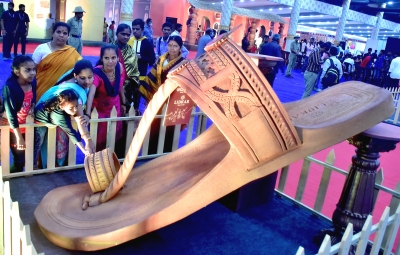GST rate cut to boost MSMEs, push exports
By IANS | Updated: September 5, 2025 21:50 IST2025-09-05T21:45:57+5:302025-09-05T21:50:10+5:30
New Delhi, Sep 5 These measures not only ease the cost of doing business but also align with broader ...

GST rate cut to boost MSMEs, push exports
New Delhi, Sep 5
These measures not only ease the cost of doing business but also align with broader national priorities of promoting exports, supporting artisans and farmers, and encouraging sustainable manufacturing. Collectively, the reforms reinforce India’s growth trajectory by creating a more efficient, inclusive, and globally competitive tax framework, the statement said.
The cut in GST from 12 per cent to 5 per cent will boost the leather and footwear sector, which is a key employer in India, with a strong export base. GST rationalisation here reduces the burden on manufacturers and makes products more accessible to consumers. Lower taxation is expected to improve the global competitiveness of Indian footwear and leather exports.
E-commerce is one of the fastest-growing sectors, heavily dependent on cost-effective packaging and logistics. GST reductions in this area lower costs for both businesses and consumers. Packing paper, cases, cartons, boxes (of corrugated paper or non-corrugated paper or paper boards) and paper pulp moulded trays will now be taxed at 5 per cent, reducing packaging and shipping costs per order.
Reduction in GST on trucks and delivery vans (from 28 per cent to 18 per cent) decreases freight rates per tonne-km, improving efficiency of last-mile deliveries. Trucks are the backbone of India’s supply chain. They carry 65 to 70 per cent of goods traffic in India. Cheaper trucks will directly help in reducing logistics costs, improving export competitiveness. The combined effect supports logistics, warehousing, and online retail ecosystems, enhancing India’s competitiveness in global supply chains.
Agro-based and eco-friendly wood substitutes also see lower taxation at 5 per cent, encouraging sustainable manufacturing and MSME competitiveness.
The handicrafts sector, vital for artisans and exports, benefits from tax rationalisation, making traditional goods more affordable and globally competitive with GST reduced from 12 per cent to 5 per cent.
Agro-processing industries will also gain from reduced GST, promoting cold storage and reducing food wastage. Reduction of GST on most of the food items to 5 per cent or zero, strengthens the entire food processing value chain from farmers to MSMEs, from retailers to exporters.
Similarly, the GST rationalisation in textiles removes structural anomalies, reduces costs, boosts demand, supports exports, and sustains jobs. It will strengthen the entire textile value chain from fibre to garment, by reducing cost distortions. It will also correct anomalies at the fibre stage, as the GST cut to 5 per cent will reduce costs at the yarn/fabric stage, boosting garment affordability, reviving demand at the retail stage, and enhancing export competitiveness.
The toy industry, important for child development and MSME manufacturing, will also benefit from the GST rate being reduced from 12 per cent to 5 per cent, the statement added.
Disclaimer: This post has been auto-published from an agency feed without any modifications to the text and has not been reviewed by an editor
Open in app